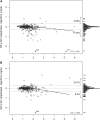Estimating baseline kidney function in hospitalized patients with impaired kidney function
- PMID: 22422536
- PMCID: PMC3338282
- DOI: 10.2215/CJN.10821011
Estimating baseline kidney function in hospitalized patients with impaired kidney function
Abstract
Background and objectives: Inaccurate determination of baseline kidney function can misclassify acute kidney injury (AKI) and affect the study of AKI-related outcomes. No consensus exists on how to optimally determine baseline kidney function when multiple preadmission creatinine measurements are available.
Design, setting, participants, & measurements: The accuracy of commonly used methods for estimating baseline serum creatinine was compared with that of a reference standard adjudicated by a panel of board-certified nephrologists in 379 patients with AKI or CKD admitted to a tertiary referral center.
Results: Agreement between estimating methods and the reference standard was highest when using creatinine values measured 7-365 days before admission. During this interval, the intraclass correlation coefficient (ICC) for the mean outpatient serum creatinine level (0.91 [95% confidence interval (CI), 0.88-0.92]) was higher than the most recent outpatient (ICC, 0.84 [95% CI, 0.80-0.88]; P<0.001) and the nadir outpatient (ICC, 0.83 [95% CI, 0.76-0.87; P<0.001) serum creatinine. Using the final creatinine value from a prior inpatient admission increased the ICC of the most recent outpatient creatinine method (0.88 [95% CI, 0.85-0.91]). Performance of all methods declined or was unchanged when the time interval was broadened to 2 years or included serum creatinine measured within a week of admission.
Conclusions: The mean outpatient serum creatinine measured within a year of hospitalization most closely approximates nephrologist-adjudicated serum creatinine values.
Figures



Comment in
-
Predicting baseline creatinine in hospitalized patients.Clin J Am Soc Nephrol. 2012 May;7(5):697-9. doi: 10.2215/CJN.03020312. Epub 2012 Apr 19. Clin J Am Soc Nephrol. 2012. PMID: 22516287 No abstract available.
-
Estimating baseline kidney function in hospitalized patients with impaired kidney function.Ann Clin Biochem. 2013 Jan;50(1):89. doi: 10.1258/acb.2012.201226. Ann Clin Biochem. 2013. PMID: 28071065 No abstract available.
References
-
- Joannidis M, Metnitz B, Bauer P, Schusterschitz N, Moreno R, Druml W, Metnitz PG: Acute kidney injury in critically ill patients classified by AKIN versus RIFLE using the SAPS 3 database. Intensive Care Med 35: 1692–1702, 2009 - PubMed
-
- Chertow GM, Burdick E, Honour M, Bonventre JV, Bates DW: Acute kidney injury, mortality, length of stay, and costs in hospitalized patients. J Am Soc Nephrol 16: 3365–3370, 2005 - PubMed
-
- Nash K, Hafeez A, Hou S: Hospital-acquired renal insufficiency. Am J Kidney Dis 39: 930–936, 2002 - PubMed
Publication types
MeSH terms
Substances
Grants and funding
LinkOut - more resources
Full Text Sources
Medical

